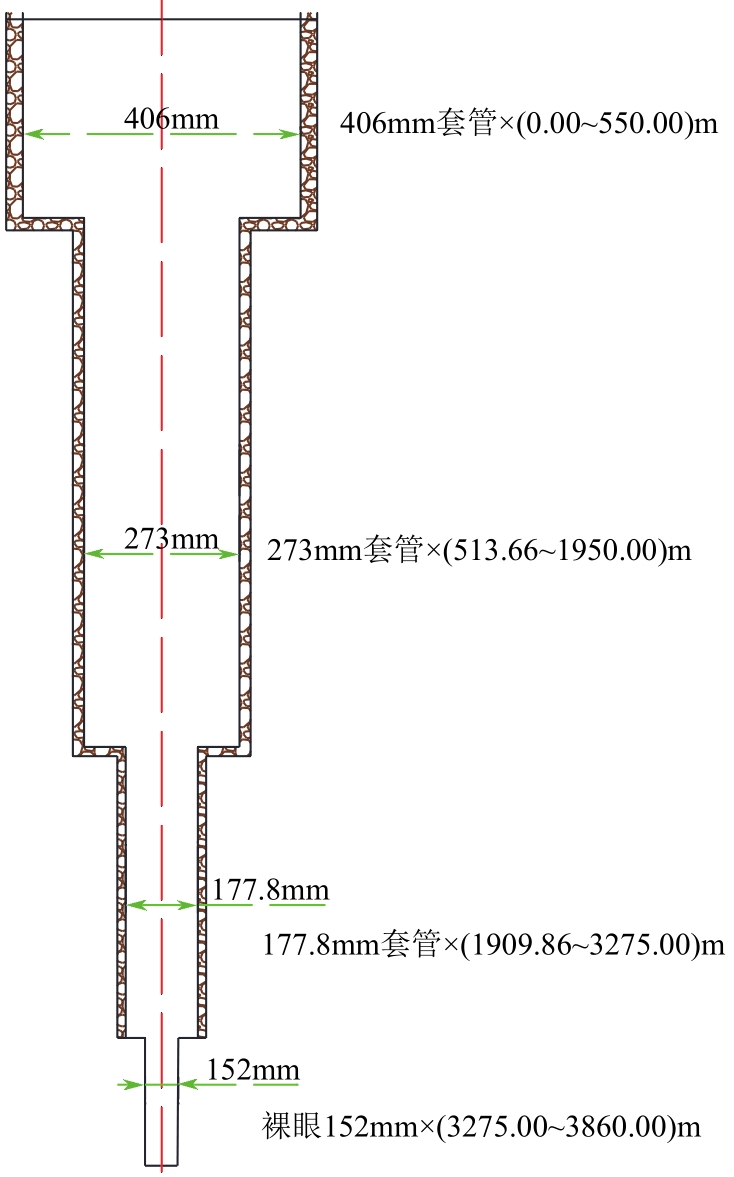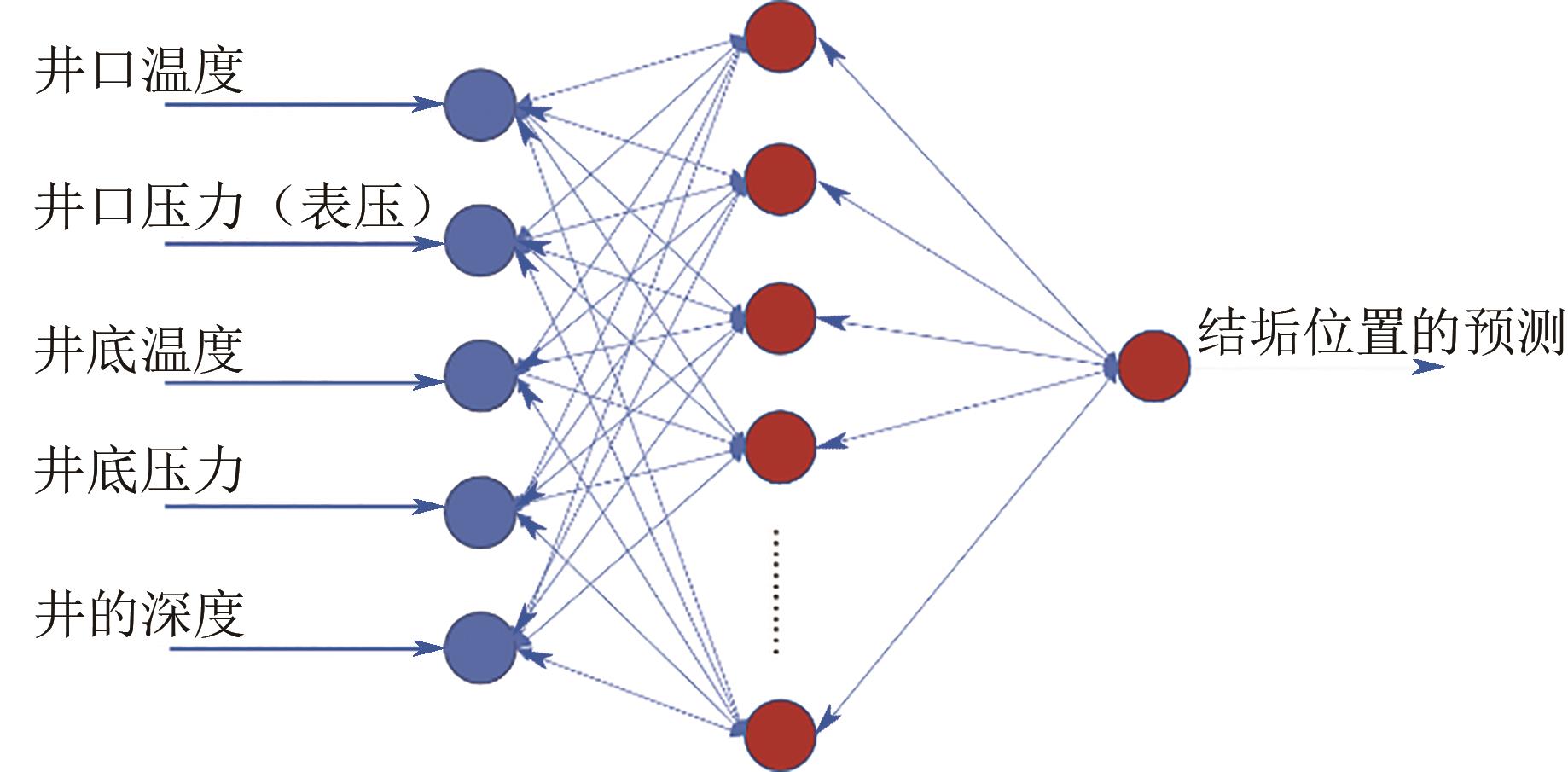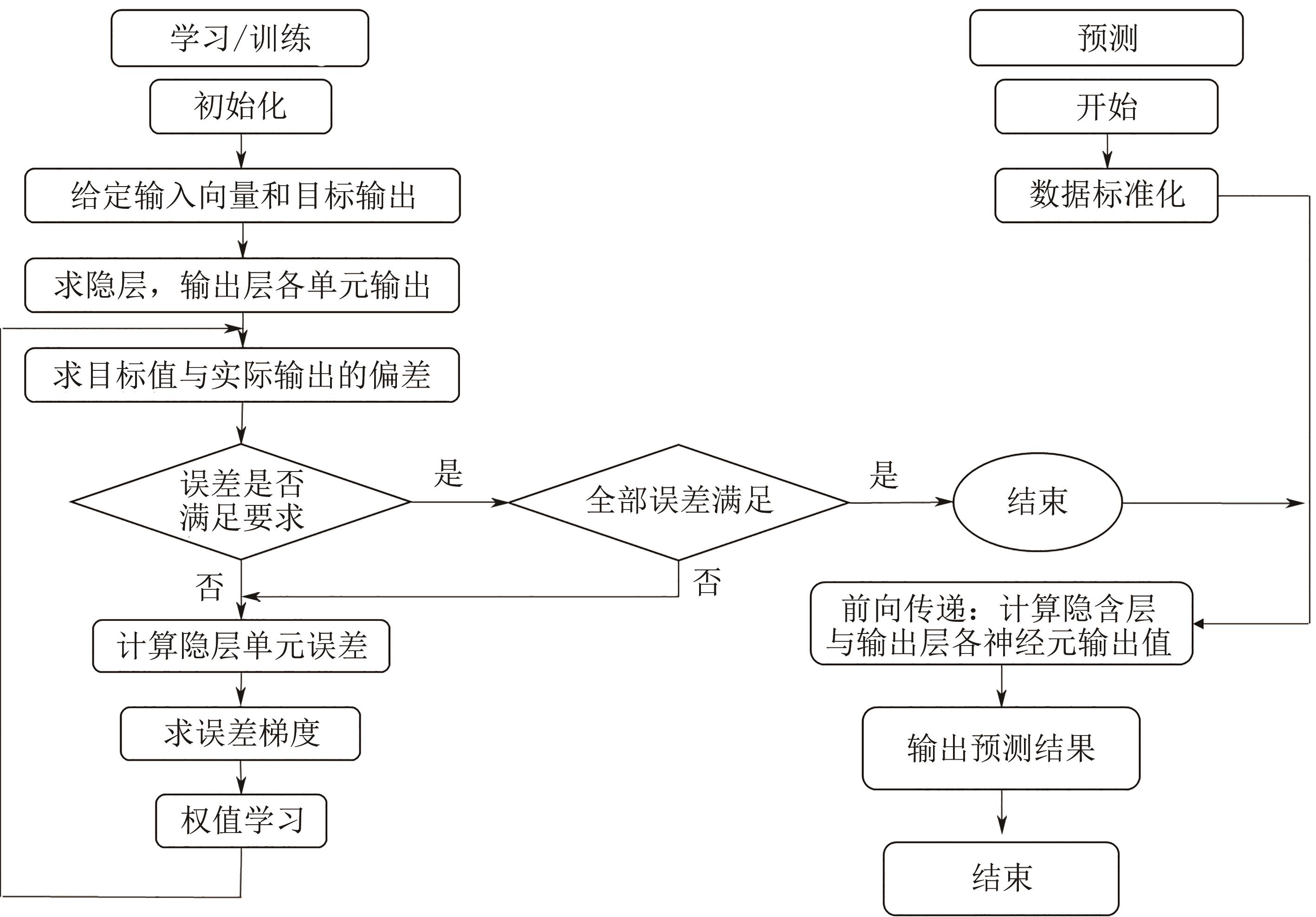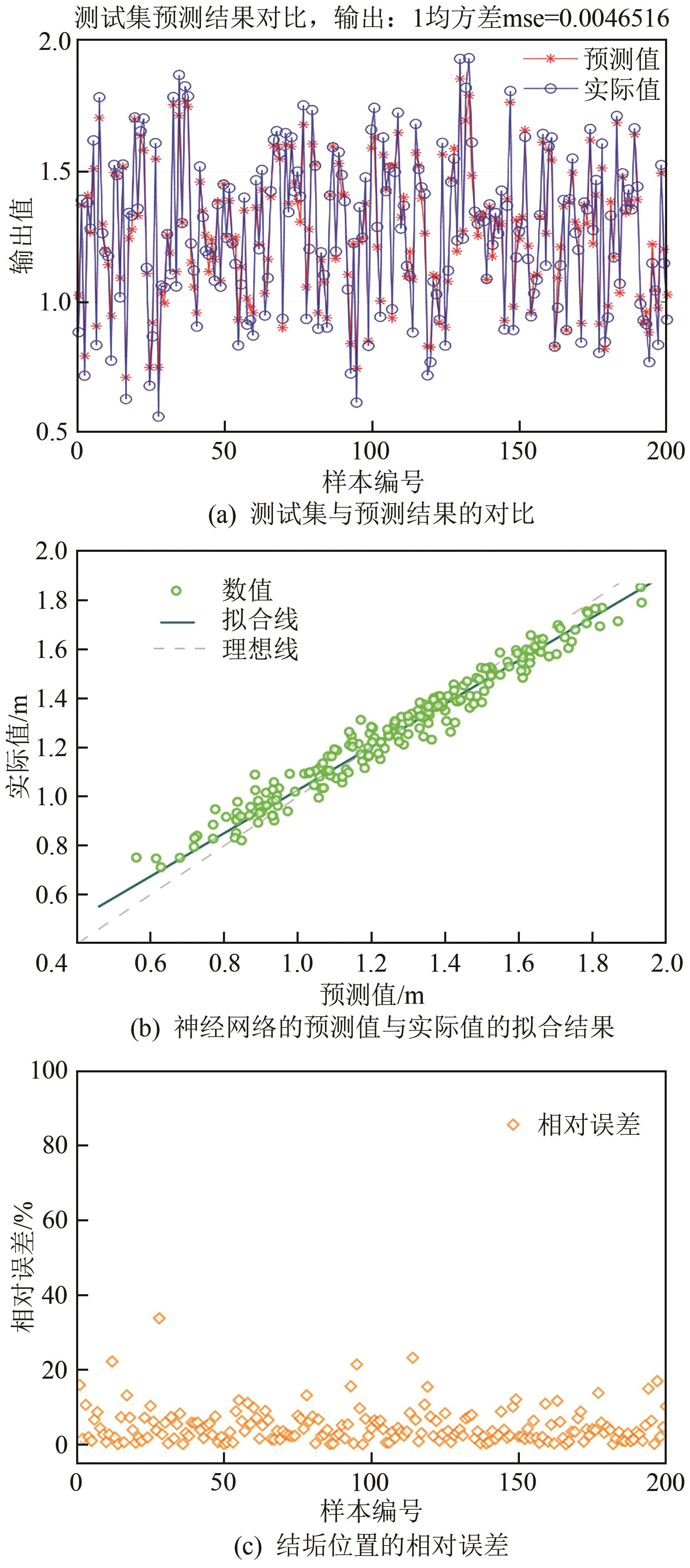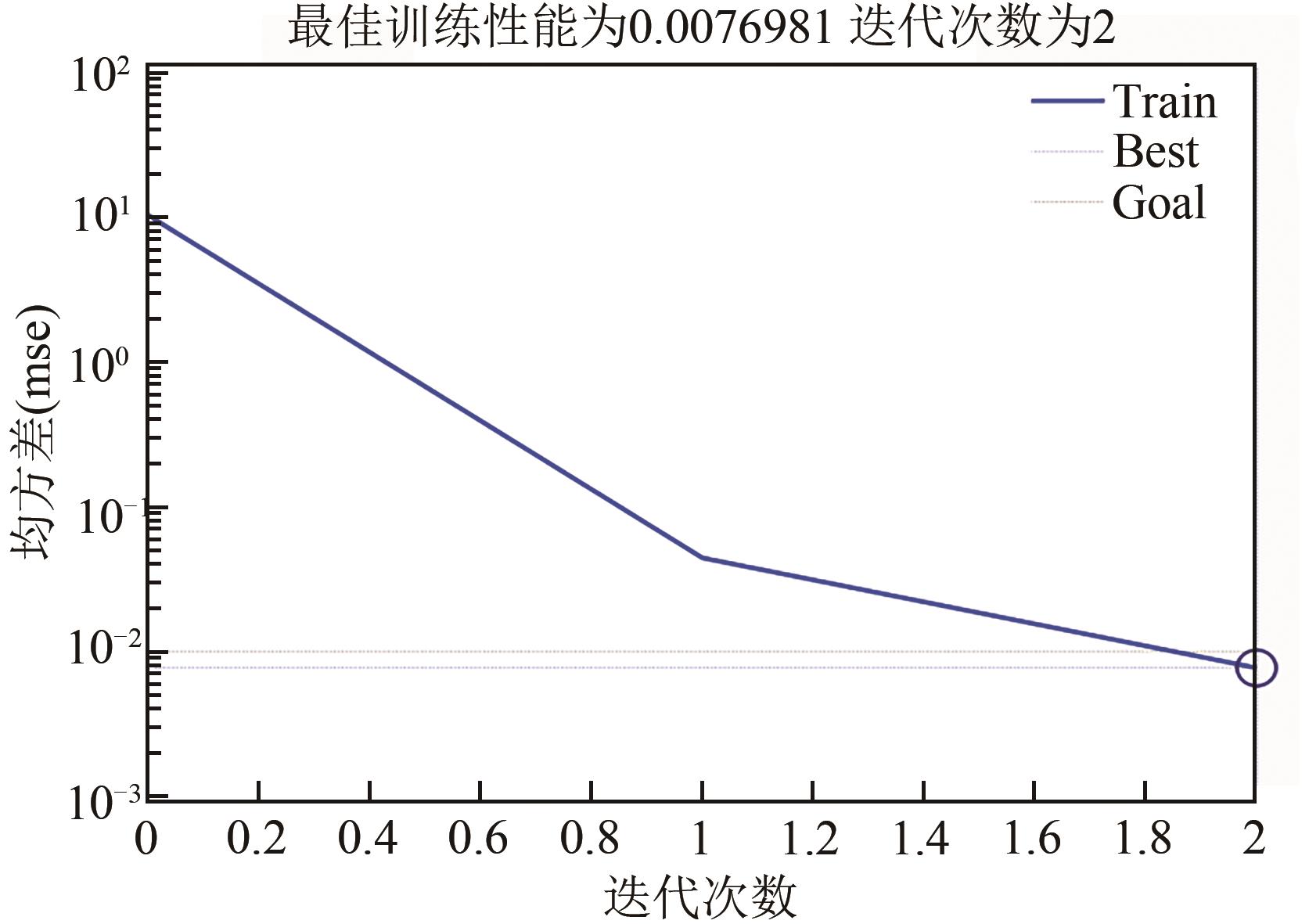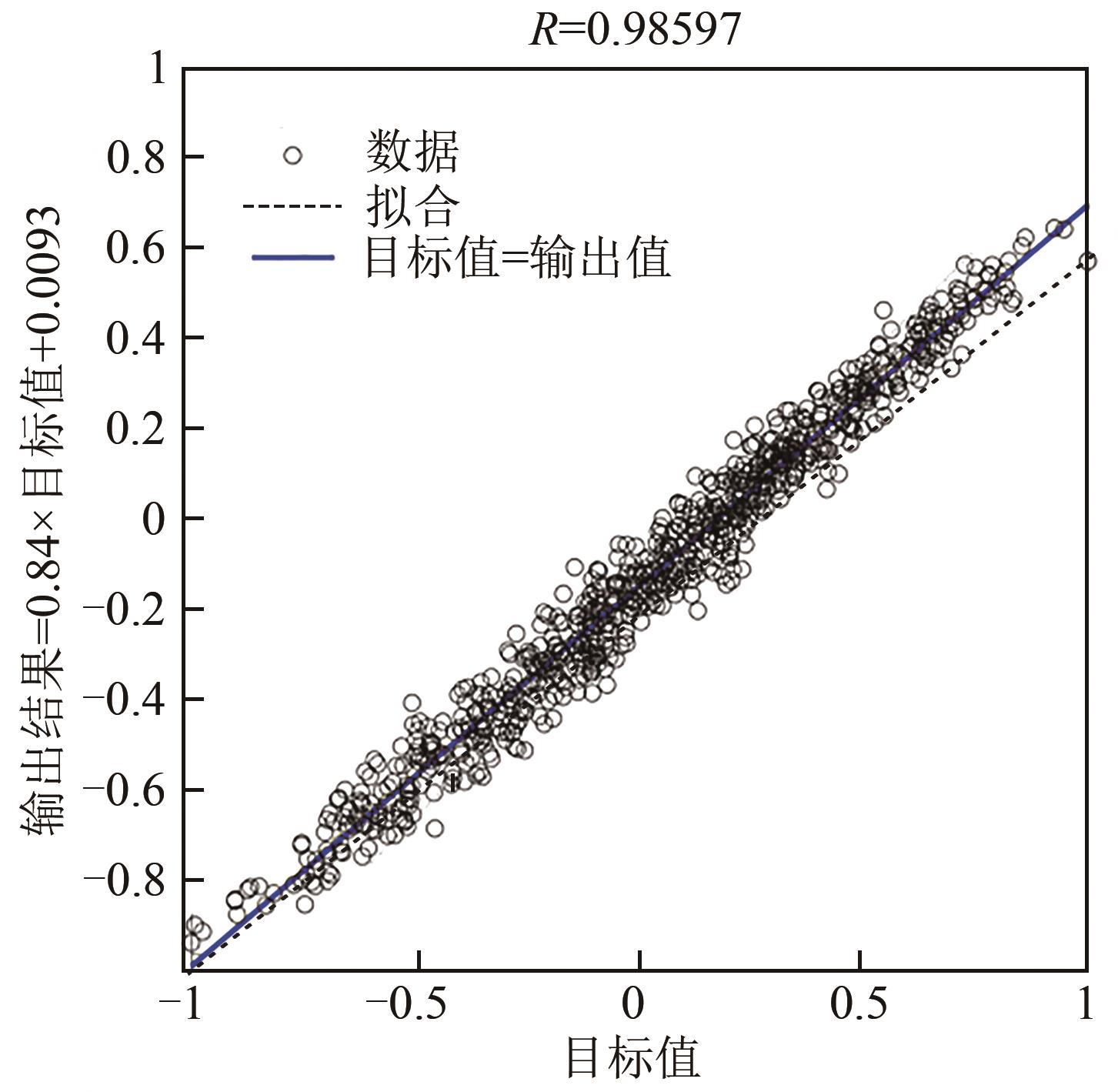Chemical Industry and Engineering Progress ›› 2022, Vol. 41 ›› Issue (11): 5761-5770.DOI: 10.16085/j.issn.1000-6613.2022-0216
• Energy processes and technology • Previous Articles Next Articles
Prediction of scaling location of fluid in geothermal well based on BP artificial neural network
LI Shuai1( ), LIU Mingyan1,2(
), LIU Mingyan1,2( ), MA Yongli1
), MA Yongli1
- 1.School of Chemical Engineering and Technology, Tianjin University, Tianjin 300350, China
2.State Key Laboratory of Chemical Engineering (Tianjin University), Tianjin 300350, China
-
Received:2022-02-11Revised:2022-03-21Online:2022-11-28Published:2022-11-25 -
Contact:LIU Mingyan
基于BP人工神经网络预测地热井中流体的结垢位置
- 1.天津大学化工学院,天津 300350
2.化学工程联合国家重点实验室(天津大学),天津 300350
-
通讯作者:刘明言 -
作者简介:李帅(1995—),男,硕士研究生。E-mail: li568479439@163.com。 -
基金资助:国家重点研发计划(2019YFB1504104)
CLC Number:
Cite this article
LI Shuai, LIU Mingyan, MA Yongli. Prediction of scaling location of fluid in geothermal well based on BP artificial neural network[J]. Chemical Industry and Engineering Progress, 2022, 41(11): 5761-5770.
李帅, 刘明言, 马永丽. 基于BP人工神经网络预测地热井中流体的结垢位置[J]. 化工进展, 2022, 41(11): 5761-5770.
share this article
Add to citation manager EndNote|Ris|BibTeX
URL: https://hgjz.cip.com.cn/EN/10.16085/j.issn.1000-6613.2022-0216
| 井的开度 | 井深/m | 套管直径/mm | 壁厚/mm |
|---|---|---|---|
| 一开 | 550.00 | 406.0 | 9.65 |
| 二开 | 1950.00 | 273.0 | 8.94 |
| 三开 | 3275.00 | 177.8 | 9.19 |
| 四开 | 3860.00 | 152.0 | — |
| 井的开度 | 井深/m | 套管直径/mm | 壁厚/mm |
|---|---|---|---|
| 一开 | 550.00 | 406.0 | 9.65 |
| 二开 | 1950.00 | 273.0 | 8.94 |
| 三开 | 3275.00 | 177.8 | 9.19 |
| 四开 | 3860.00 | 152.0 | — |
| 算法 | 函数 |
|---|---|
| 梯度下降法 | traingd |
| 有动量的梯度下降法 | traingdm |
| 自适应lr梯度下降法 | traingda |
| 自适应lr动量梯度下降法 | traingdx |
| 弹性梯度下降法 | trainrp |
| Fletcher-Reeves共轭梯度法 | traincgf |
| Ploak-Ribiere共轭梯度法 | traincgp |
| Powell-Beale共轭梯度法 | traincgb |
| 量化共轭梯度法 | trainscg |
| 拟牛顿算法 | trainbfg |
| 一步正割算法 | trainoss |
| Levenberg-Marquardt | trainlm |
| 算法 | 函数 |
|---|---|
| 梯度下降法 | traingd |
| 有动量的梯度下降法 | traingdm |
| 自适应lr梯度下降法 | traingda |
| 自适应lr动量梯度下降法 | traingdx |
| 弹性梯度下降法 | trainrp |
| Fletcher-Reeves共轭梯度法 | traincgf |
| Ploak-Ribiere共轭梯度法 | traincgp |
| Powell-Beale共轭梯度法 | traincgb |
| 量化共轭梯度法 | trainscg |
| 拟牛顿算法 | trainbfg |
| 一步正割算法 | trainoss |
| Levenberg-Marquardt | trainlm |
井底 温度/℃ | 井底压力/MPa | 井口 温度/℃ | 井口压力/MPa | 一开井深度/m | 二开井深度/m | 三开井深度/m | 四开井深度/m |
|---|---|---|---|---|---|---|---|
| 116 | 28 | 95 | 0.186 | 550 | 1950 | 3275 | 3860 |
| 128 | 34 | 110 | 0.180 | 450 | 2205 | 3165 | 3758 |
井底 温度/℃ | 井底压力/MPa | 井口 温度/℃ | 井口压力/MPa | 一开井深度/m | 二开井深度/m | 三开井深度/m | 四开井深度/m |
|---|---|---|---|---|---|---|---|
| 116 | 28 | 95 | 0.186 | 550 | 1950 | 3275 | 3860 |
| 128 | 34 | 110 | 0.180 | 450 | 2205 | 3165 | 3758 |
| 序号 | 预测结果/m | 实际结果/m | 绝对误差 | 相对误差/% |
|---|---|---|---|---|
| 1 | 1.580 | 1.500 | 0.080 | 5.06 |
| 2 | 33.069 | 30.000 | 3.069 | 9.28 |
| 序号 | 预测结果/m | 实际结果/m | 绝对误差 | 相对误差/% |
|---|---|---|---|---|
| 1 | 1.580 | 1.500 | 0.080 | 5.06 |
| 2 | 33.069 | 30.000 | 3.069 | 9.28 |
| 1 | 《中国地热能发展报告(2018)》白皮书发布[J]. 地质装备, 2019, 20(2): 3-6. |
| China geothermal energy development report (2018) [J]. Equipment for Geotechnical Engineering, 2019, 20(2): 3-6. | |
| 2 | 蔡义汉. 地热直接利用[M]. 天津: 天津大学出版社, 2004. |
| CAI Yihan. Geothermal direct-use[M]. Tianjin: Tianjin University Press, 2004. | |
| 3 | ODDO J E, TOMSON M B. Why scale forms in the oil field and methods to predict it[J]. SPE Production & Facilities, 1994, 9(1): 47-54. |
| 4 | BOCH Ronny, LEIS Albrecht, HASLINGER Edith, et al. Scale-fragment formation impairing geothermal energy production: interacting H2S corrosion and CaCO3 crystal growth[J]. Geothermal Energy, 2017, 5(1): 1-19. |
| 5 | 刘明言. 地热流体的腐蚀与结垢控制现状[J]. 新能源进展, 2015, 3(1): 38-46. |
| LIU Mingyan. A review on controls of corrosion and scaling in geothermal fluids[J]. Advances in New and Renewable Energy, 2015, 3(1): 38-46. | |
| 6 | 刘明言, 朱家玲. 地热能利用中的防腐防垢研究进展[J]. 化工进展, 2011, 30(5): 1120-1123. |
| LIU Mingyan, ZHU Jialing. Progress of corrosion and fouling prevention in utilization of geothermal energy[J]. Chemical Industry and Engineering Progress, 2011, 30(5): 1120-1123. | |
| 7 | TOPCU Gokhan, KOÇ Gonca A, BABA Alper, et al. The injection of CO2 to hypersaline geothermal brine: a case study for Tuzla region[J]. Geothermics, 2019, 80: 86-91. |
| 8 | LEDÉSERT Béatrice A, HÉBERT Ronan L, MOUCHOT Justine, et al. Scaling in a geothermal heat exchanger at soultz-sous-forêts (upper Rhine graben, France): a XRD and SEM-EDS characterization of sulfide precipitates[J]. Geosciences, 2021, 11(7): 271. |
| 9 | 李义曼, 庞忠和. 地热系统碳酸钙垢形成原因及定量化评价[J]. 新能源进展, 2018, 6(4): 274-281. |
| LI Yiman, PANG Zhonghe. Carbonate calcium scale formation and quantitative assessment in geothermal system[J]. Advances in New and Renewable Energy, 2018, 6(4): 274-281. | |
| 10 | 蔡正敏, 李刚, 李源, 等. 肯尼亚地热电站结垢问题的日常维护[J]. 科技视界, 2018(25): 41-43. |
| CAI Zhengmin, LI Gang, LI Yuan, et al. Maintenance of geothermal power plant in Kenya[J]. Science & Technology Vision, 2018(25): 41-43. | |
| 11 | SATMAN Abdurrahman, UGUR Zuleyha, ONUR Mustafa. The effect of calcite deposition on geothermal well inflow performance[J]. Geothermics, 1999, 28(3): 425-444. |
| 12 | Gabriella STÁHL, György PÁTZAY, László WEISER, et al. Study of calcite scaling and corrosion processes in geothermal systems[J]. Geothermics, 2000, 29(1): 105-119. |
| 13 | SPINTHAKI Argyro, MATHEIS Juergen, HATER Wolfgang, et al. Antiscalant-driven inhibition and stabilization of “magnesium silicate” under geothermal stresses: the role of magnesium-phosphonate coordination chemistry[J]. Energy & Fuels, 2018, 32(11): 11749-11760. |
| 14 | Stefán ARNÓRSSON, SIGURDSSON Sven, Hördur SVAVARSSON. The chemistry of geothermal waters in Iceland. Ⅰ. Calculation of aqueous speciation from 0° to 370℃[J]. Geochimica et Cosmochimica Acta, 1982, 46(9): 1513-1532. |
| 15 | Gültekin TARCAN, Tuğbanur ÖZEN, Ünsal GEMICI, et al. Geochemical assessment of mineral scaling in Kzldere geothermal field, Turkey[J]. Environmental Earth Sciences, 2016, 75(19): 1317-1335. |
| 16 | REED M H, SPYCHER N F, PALANDRI J. Users guide for CHIM-XPT: a program for computing reaction processes in aqueous-mineral-gas systems and MINTAB guide[M]. version 2.43. Eugene, Oregon: University of Oregon, 2012. |
| 17 | Stefán ARNÓRSSON. Deposition of calcium carbonate minerals from geothermal waters—Theoretical considerations[J]. Geothermics, 1989, 18(1/2): 33-39. |
| 18 | O'SULLIVAN Michael J, PRUESS Karsten, LIPPMANN Marcelo J. State of the art of geothermal reservoir simulation[J]. Geothermics, 2001, 30(4): 395-429. |
| 19 | BÄCHLER D, KOHL T. Coupled thermal-hydraulic-chemical modelling of enhanced geothermal systems[J]. Geophysical Journal International, 2005, 161(2): 533-548. |
| 20 | RYLEY D J. The mass discharge of a geofluid from a geothermal reservoir—Well system with flashing flow in the bore[J]. Geothermics, 1980, 9(3/4): 221-235. |
| 21 | CHADHA P K, MALIN M R, PALACIO-PEREZ A. Modelling of two-phase flow inside geothermal wells[J]. Applied Mathematical Modelling, 1993, 17(5): 236-245. |
| 22 | BARELLI A, CORSI R, Del PIZZO G, et al. A two-phase flow model for geothermal wells in the presence of non-condensable gas[J]. Geothermics, 1982, 11(3): 175-191. |
| 23 | BANKOFF S G. A variable density single-fluid model for two-phase flow with particular reference to steam-water flow[J]. Journal of Heat Transfer, 1960, 82(4): 265-272. |
| 24 | PÁTZAY G, STÁHL G, KÁRMÁN F H, et al. Modeling of scale formation and corrosion from geothermal water[J]. Electrochimica Acta, 1998, 43(1/2): 137-147. |
| 25 | AKIN Taylan, Aygün GÜNEY, KARGI Hulusi. Modeling of calcite scaling and estimation of gas breakout depth in a geothermal well by using PHREEQC[C]//Fortieth Workshop on Geothermal Reservoir Engineering. Stanford University, Stanford, California, 2015:1-8. |
| 26 | HAIZLIP Jill, Aygün GÜNEY, HAKLIDIR Fusun Servin Tut, et al. The impact of high noncondensible gas concentrations on well performance Kizildere geothermal reservoir, TURKEY[C]// Thirty-Seventh Workshop on Geothermal Reservoir Engineering. Stanford University, Stanford, California 2013:1-6. |
| 27 | BJORNSSON G. A multi-feedzone geothermal wellbore simulator[R]. Office of Scientific and Technical Information (OSTI), 1987. |
| 28 | GUNN Calum, FREESTON Derek. An integrated steady-state wellbore simulation and analysis package[C]//Proceedings of the 13th New Zealand Geothermal Workshop. Auckland, NZ: New Zealand Geothermal Workshop,1991: 161-166. |
| 29 | GARG Sabodh K, PRITCHETT John W, ALEXANDER James H. A new liquid hold-up correlation for geothermal wells[J]. Geothermics, 2004, 33(6): 795-817. |
| 30 | 王龙洋, 蒙西, 乔俊飞. 基于改进集合经验模态分解和深度信念网络的出水总磷预测[J]. 化工学报, 2021(5): 2745-2753. |
| WANG Longyang, MENG Xi, QIAO Junfei. Prediction of effluent total phosphorus based on modified ensemble empirical mode decomposition and deep belief network[J]. CIESC Journal, 2021(5): 2745-2753. | |
| 31 | ZHANG Guoqiang, EDDY Patuwo B, HU Michael Y. Forecasting with artificial neural networks[J]. International Journal of Forecasting, 1998, 14(1): 35-62. |
| 32 | AYDIN Hakki, AKIN Serhat, SENTURK Erdinc. A proxy model for determining reservoir pressure and temperature for geothermal wells[J]. Geothermics, 2020, 88: 101916. |
| 33 | A Álvarez del CASTILLO, SANTOYO E, GARCÍA-VALLADARES O. Α new void fraction correlation inferred from artificial neural networks for modeling two-phase flows in geothermal wells[J]. Computers & Geosciences, 2012, 41: 25-39. |
| 34 | 赵黎丽. 两种人工智能方法应用于地热热泵系统辨识[J]. 系统仿真学报, 2004, 16(7): 1376-1379. |
| ZHAO Lili. Two artificial intelligent methods applied in the identification of geothermal heat pump system[J]. Acta Simulata Systematica Sinica, 2004, 16(7): 1376-1379. | |
| 35 | 梁海军, 郭啸峰, 高涛, 等. 河北博野某地热井结垢位置预测及影响因素分析[J]. 石油钻探技术, 2020, 48(5): 105-110. |
| LIANG Haijun, GUO Xiaofeng, GAO Tao, et al. Scaling spot prediction and analysis of influencing factors for a geothermal well in Boye County, Hebei Province[J]. Petroleum Drilling Techniques, 2020, 48(5): 105-110. | |
| 36 | BASSAM A, ORTEGA-TOLEDO D, HERNANDEZ J A, et al. Artificial neural network for the evaluation of CO2 corrosion in a pipeline steel[J]. Journal of Solid State Electrochemistry, 2009, 13(5): 773-780. |
| 37 | 张冰, 唐和礼, 黄冬梅, 等. 人工神经网络及智能算法在膜污染研究中的应用[J]. 膜科学与技术, 2021, 41(4): 160-169. |
| ZHANG Bing, TANG Heli, HUANG Dongmei, et al. Applications of artificial neural networks and intelligent algorithms in the research of membrane fouling: a critical review[J]. Membrane Science and Technology, 2021, 41(4): 160-169. | |
| 38 | 张驰, 郭媛, 黎明. 人工神经网络模型发展及应用综述[J]. 计算机工程与应用, 2021, 57(11): 57-69. |
| ZHANG Chi, GUO Yuan, LI Ming. Review of development and application of artificial neural network models[J]. Computer Engineering and Applications, 2021, 57(11): 57-69. |
| [1] | LI Huaquan, WANG Minghua, QIU Guibao. Behavior of sulfuric acid acidolysis of perovskite concentrates [J]. Chemical Industry and Engineering Progress, 2023, 42(S1): 536-541. |
| [2] | XU Chenyang, DU Jian, ZHANG Lei. Chemical reaction evaluation based on graph network [J]. Chemical Industry and Engineering Progress, 2023, 42(S1): 205-212. |
| [3] | LI Xuejia, LI Peng, LI Zhixia, JIN Dunshang, GUO Qiang, SONG Xufeng, SONG Peng, PENG Yuelian. Experimental comparation on anti-scaling and anti-wetting ability of hydrophilic and hydrophobic modified membranes [J]. Chemical Industry and Engineering Progress, 2023, 42(8): 4458-4464. |
| [4] | CHEN Sen, YIN Pengyuan, YANG Zhenglu, MO Yiming, CUI Xili, SUO Xian, XING Huabin. Advances in the intelligent synthesis of functional solid materials [J]. Chemical Industry and Engineering Progress, 2023, 42(7): 3340-3348. |
| [5] | WANG Shuo, ZHANG Yaxin, ZHU Botao. Prediction of erosion life of coal water slurry pipeline based on grey prediction model [J]. Chemical Industry and Engineering Progress, 2023, 42(7): 3431-3442. |
| [6] | LIU Zhanjian, FU Yuxin, REN Lina, ZHANG Xiguang, YUAN Zhongtao, YANG Nan, WANG Huaiyuan. New research progress of superhydrophobic coatings in the field of anti-corrosion and anti-scaling [J]. Chemical Industry and Engineering Progress, 2023, 42(6): 2999-3011. |
| [7] | ZHAO Jingbin, WANG Yanfu, WANG Tao, MA Weikai, WANG Chen. Vulnerability assessment of storage tanks based on Monte Carlo simulation and dynamic event tree [J]. Chemical Industry and Engineering Progress, 2023, 42(5): 2751-2759. |
| [8] | HE Shanming, PAN Jiechang, XU Guozuan, LI Wenjun, LIANG Yong. Thermodynamic analysis and experimental verification of chromium and vanadium removal by ferrous salt precipitation from crude sodium tungstate solution [J]. Chemical Industry and Engineering Progress, 2023, 42(4): 2171-2179. |
| [9] | ZHANG Jianwei, XU Rui, ZHANG Zhongchuang, DONG Xin, FENG Ying. Mixing characteristics of concentration field in impingement flow reactor based on convolutional neural network [J]. Chemical Industry and Engineering Progress, 2023, 42(2): 658-668. |
| [10] | WANG Lu, ZHANG Lei, DU Jian. High-throughput screening of zeolite materials for CO2/N2 selective adsorption separation by machine learning [J]. Chemical Industry and Engineering Progress, 2023, 42(1): 148-158. |
| [11] | KONG Qian, SUN Jinchao, GE Jiaqi, ZHANG Peng, MA Yanlong, LIU Baijun. Effect of precipitant on the hydrocracking performance of NiW/TiO2-ASA catalyst [J]. Chemical Industry and Engineering Progress, 2023, 42(1): 265-271. |
| [12] | LI Wei, RUAN Chenglong, WANG Xiaoming, LI Yajie, LIANG Chenglong. Integrated modelling method for tank-batch finished gasoline blending formulations [J]. Chemical Industry and Engineering Progress, 2022, 41(9): 4701-4712. |
| [13] | FENG Ying, ZHAO Mengjie, CUI Qian, XIE Yuju, ZHANG Jianwei, DONG Xin. Research progress of molecular simulation technology in the development and application of chitosan functional materials [J]. Chemical Industry and Engineering Progress, 2022, 41(8): 4241-4253. |
| [14] | YANG Lei, SONG Jinling, TANG Chuyang, YU Shiyao, YANG Xinyu. Products prediction of carbon-based solid waste pyrolysis based on FUSION model [J]. Chemical Industry and Engineering Progress, 2022, 41(7): 3966-3973. |
| [15] | QIU Qili, JIANG Xuguang. Application of municipal solid waste incineration fly ash in the field of pollutant control [J]. Chemical Industry and Engineering Progress, 2022, 41(7): 3855-3864. |
| Viewed | ||||||
|
Full text |
|
|||||
|
Abstract |
|
|||||
